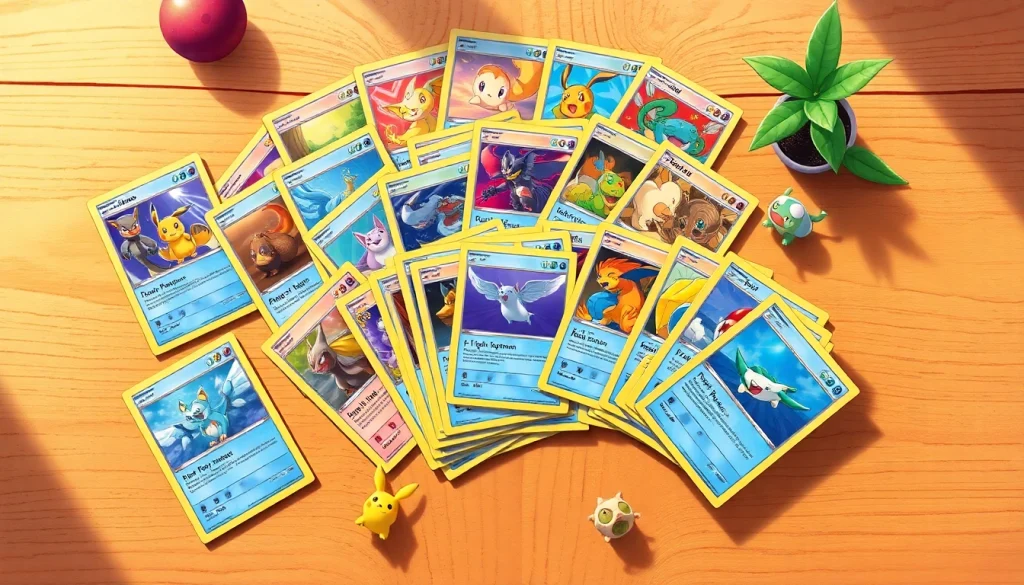The Ultimate Guide to Real Pokémon Cards: Buy, Spot, and Collect

Understanding Real Pokémon Cards
Pokémon cards have captured the imagination of millions around the world, serving not just as collectibles, but also as a way for fans to engage with the Pokémon universe. For both seasoned collectors and newcomers alike, understanding the nuances of real pokemon cards is crucial. This comprehensive guide will delve into what constitutes a real Pokémon card, the importance of authenticity in the collecting world, and the common characteristics that define genuine cards.
What Are Real Pokémon Cards?
Real Pokémon cards are officially licensed products produced by The Pokémon Company and its partners. These cards are part of the Trading Card Game (TCG) and can be used in gameplay, traded, or collected. A legitimate Pokémon card will have proper branding, correct print quality, and specific features that distinguish it from counterfeit or fake cards. Understanding these features is essential for anyone looking to invest in Pokémon cards, either for personal enjoyment or as a financial asset.
Importance of Authenticity in Pokémon Collecting
The market for Pokémon cards has exploded in recent years, leading to a surge in counterfeit products. Ensuring that you are purchasing authentic cards is crucial for collectors, as fake cards can diminish the value of a collection significantly. Authenticity guarantees that the card is a true representation of the Pokémon franchise, benefiting both collectors and the market at large. Furthermore, real cards often possess sentimental value that goes beyond mere monetary worth, embedding themselves into the broader culture of fandom and nostalgia.
Common Attributes of Real Pokémon Cards
- Material Quality: Authentic Pokémon cards are made from high-quality cardstock, providing a certain weight and feel that fake cards lack.
- Print Quality: Real cards feature sharp, vibrant colors and clean printing; in contrast, counterfeits may show blurry images or inconsistent colors.
- Specific Holographic Elements: Many cards include unique holographic shines, which are difficult to replicate accurately in fakes.
- Correct Text Layout: The text on real cards follows specific formatting guidelines and includes certain identifiers such as rarity symbols, which might be absent or incorrect on fake versions.
How to Identify Real vs Fake Pokémon Cards
When venturing into the world of Pokémon collecting, knowing how to distinguish between real and fake cards is indispensable. The following sections outline specific methods to identify authentic Pokémon cards.
Visual and Textural Differences
A visual examination is often the first line of defense against counterfeit cards. Real Pokémon cards exhibit particular visual cues such as correct lighting effects and precise color schemes. Fake cards often appear oversaturated or dull. Additionally, the texture can provide clues; real cards typically have a specific finish and smooth tactility that enhances their appeal, whereas counterfeit cards may feel overly slick or too rough.
Check the Holograms and Prints
The holographic feature on many Pokémon cards is among their most distinguishing attributes. Genuine holograms exhibit complex light effects and depth that are incredibly hard to replicate in counterfeit cards. Inspecting the hologram carefully can often reveal imperfections or simplistic designs indicative of fake cards. Moreover, checking for standard print higher-grade standards on text and imagery is crucial.
Assessing Card Thickness and Feel
Real Pokémon cards are manufactured with a consistent thickness that contributes to their durability. If a card feels unusually thin or flimsy, there’s a high chance it’s fake. Moreover, the weight can also give hints; genuine cards tend to have a certain heft owing to the high-grade materials used in their production. When holding a card, pay attention to how it feels; if it lacks the right balance of flexibility and sturdiness, it’s likely not real.
Where to Buy Real Pokémon Cards
Purchasing authentic Pokémon cards has become increasingly accessible due to numerous online and brick-and-mortar retailers. However, choosing the right place to buy is crucial for ensuring product authenticity. Below are several reliable sources.
Top Online Retailers for Authentic Cards
Several online platforms are known for selling legitimate Pokémon cards. Here are a few of the most trusted:
- Pokémon Center: The official site for Pokémon collectibles, offering a variety of products including Pokémon TCG cards.
- Cardmarket: A well-established European marketplace for trading cards, featuring a wide selection of Pokémon cards.
- TCGPlayer: A popular marketplace that connects buyers and sellers of trading cards, ensuring product quality and authenticity.
Local Stores vs Online Marketplaces
While online shopping is convenient, local game stores often provide opportunities for collectors to assess cards in-person. Visiting a trusted local game store allows you to examine the condition of the cards, and often, shop owners are knowledgeable guides who can share tips on authenticity.
Safe Practices for Purchasing Pokémon Cards
To safeguard your investment, always follow these guidelines when purchasing Pokémon cards:
- Research vendor reputations – look for reviews and ratings before making purchases.
- Request detailed photographs of the cards if buying online, ensuring that you can ascertain their condition and authenticity.
- Inquire about return policies – reputable vendors will usually offer a return policy in case the cards do not meet expectations.
Building Your Collection of Real Pokémon Cards
Starting and curating a Pokémon card collection can be an enriching experience. However, to build a quality collection, it’s essential to follow structured guidelines. The following insights will help enhance your collecting experience.
Essential Pokémon Cards to Own
Depending on your collecting goals, some cards may hold greater value—both sentimentally and financially. Noteworthy cards to consider include:
- Charizard: Often seen as the most iconic Pokémon card with a high market value.
- Pikachu Illustrator: Considered one of the rarest and most valuable Pokémon cards, fetching significant auction prices.
- First Edition Cards: Cards from the original release are often sought after by collectors of all ages.
Tips for Organizing Your Collection
A well-organized collection not only helps in tracking your inventory but adds to the enjoyment of your hobby. Here are some tips:
- Use protective sleeves to safeguard cards from damage.
- Organize cards by set, type, or rarity to create a logical grouping.
- Maintain an inventory catalog, either digitally or physically, to keep track of your collection over time.
Valuing Your Pokémon Cards
Valuation of Pokémon cards can be intricate and depends on several factors, including rarity, condition, and market demand. Utilize resources such as Beckett or PSA for grading services, and frequently follow auction results on sites like eBay to gauge current market trends. Remember, the value can fluctuate dramatically based on various external factors, including the overall popularity of Pokémon media and gaming mechanics.
Engaging with the Pokémon Community
Becoming involved in the Pokémon community can greatly enhance your collecting experience. From participating in local events to connecting with other enthusiasts online, the community offers endless opportunities for engagement and growth.
Online Forums and Local Events
Platforms like Reddit, Discord, and specialized websites are excellent for discussing collecting tips, showcasing collections, and sharing experiences. Additionally, attending local tournaments or card fairs can offer not just camaraderie but also the chance to buy, sell, or trade cards with fellow fans.
Connecting with Other Collectors
Networking with fellow collectors can lead to valuable insights and opportunities. Join local Pokémon clubs or online groups where you can exchange knowledge about card values, history, and trends. Personal connections often yield chances to trade or purchase cards at fair prices, benefiting both parties.
Participating in Trading and Selling
Trading is an integral part of the Pokémon collecting experience. Ensure that you approach trades mindfully, considering fair market value while also valuing personal sentiment. Online marketplaces and local stores often offer platforms to sell duplicates or less-favored cards, helping to fund your collection upgrades.




